Beca Lipscombe
and
Lucy McKenzie
The Associates
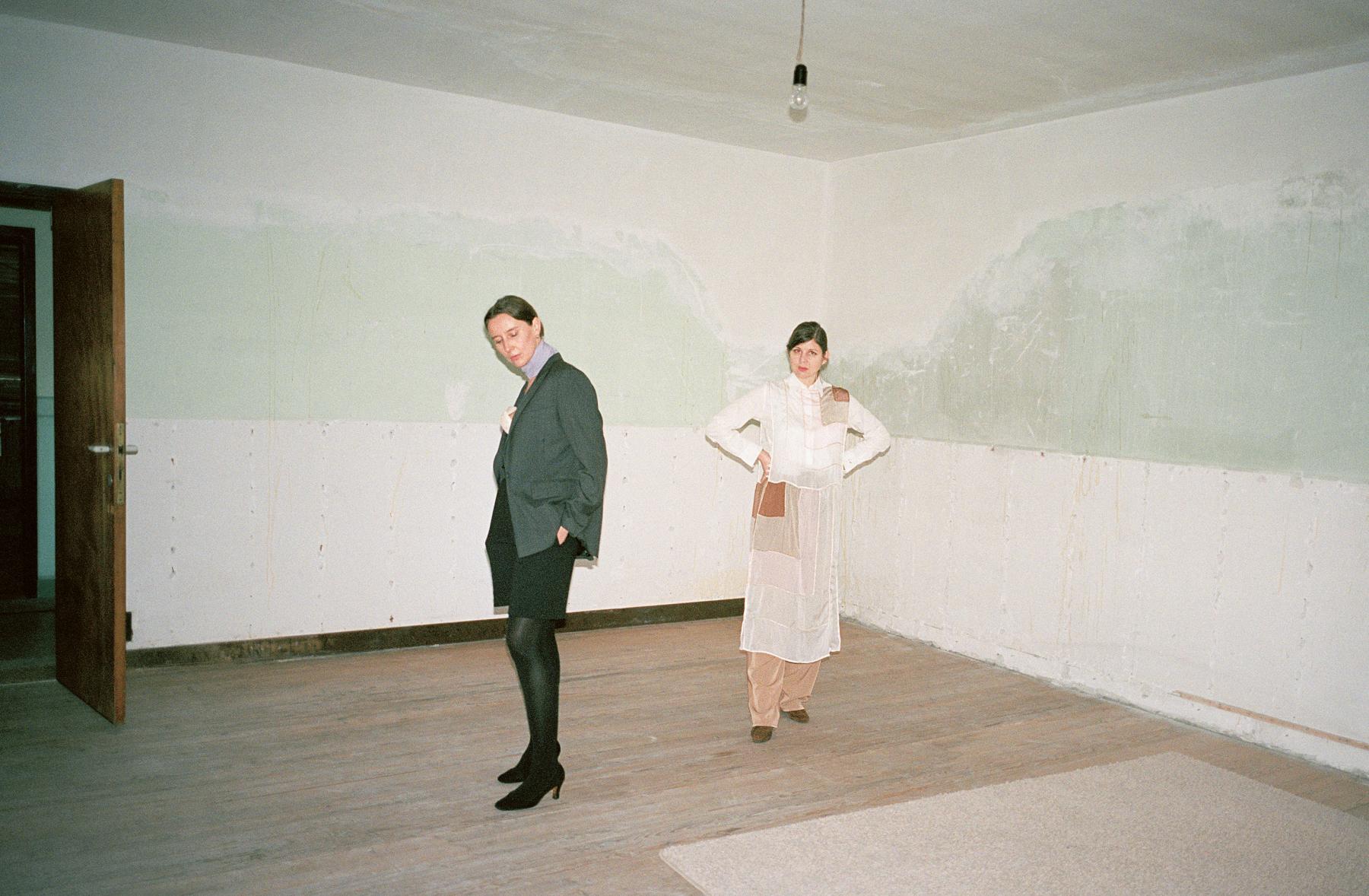
Designer Beca Lipscombe and artist Lucy McKenzie are the great minds behind the much coveted fashion label Atelier E.B. Friends for more than 20 years, the pair have established a thoroughly modern approach to the business of making clothes (mostly over WhatsApp).
Last September, The New York Times reported that the folding screen, once the preserve of old-school striptease, was making a 21st-century comeback amid the pandemic-driven rush to compartmentalise open-plan living spaces for the exigencies of home working and schooling.
Such screens are foundational to the way the textile designer Beca Lipscombe and the visual artist Lucy McKenzie run their independent fashion label, Atelier E.B, whose initials stand for their respective locales: Edinburgh and Brussels, or Bruxelles, as they style it. The pair created their first paravent — they favour the French term for a folding screen, with its seaside insinuation of protection from bluster — in 2011 for their debut collection, which they called The Inventors of Tradition. It was a sumptuous mix of intarsia knit jumpers, artists’ work coats, lavishly ribbed cashmere skirts and Aran sweaters, all made to order in mills in the Scottish Borders and rust belt.
The launch was marked by an exhibition at 21 Stockwell Street in Glasgow and a 44-page A5 publication with a gold softback cover. The exhibition was a rigorous survey of authentic manufacturing, and the aforementioned paravent segregated its various elements. “People think of factories as bad places,” Beca says when we meet at Lucy’s villa De Ooievaar in Ostend, 70 miles from Brussels, “but they can be beautiful places. I know everybody that makes for us. I know their kids. We send each other birthday cards.”
But the paravent had another function. It was sold to underwrite the cost of developing the collection, freeing individual garments from the burden of turning a profit. “Paravent I”, which had Lucy’s celebrated brushwork of the Clydebank skyline with the Singer sewing machine factory on one side and Beca’s prints of a tiled Glasgow close on the other, was sold through Lucy’s London gallery, Cabinet, for £25,000 to the stylist Anastasia Barbieri. Ten paravents have since been created.
Steeped in a desire to be, as Lucy said in the book Passer-by, “self-sufficient, self-defining and independent”, Atelier E.B is the antithesis of most fashion brands. It follows no industry schedule and is blissfully inert to the demands of fashion weeks, producing collections every two to three years. It eschews runway shows, conventional lookbooks, advertising and any number of wholesaling headaches, preferring, as Beca says, to piggyback on the existing expertise of manufacturers such as Tekla by taking a current design “and implementing our own symbolism”, or to “design things that just seem to have run out or become extinct”. Resurrected rarities include jumpers with the requisite Scottish “chunk”, as opposed to the ubiquitous Italian finish, which Beca says is “stingier and finer, more minimal”. These they manufacture using mills that Beca has enlisted for their particular specialisms, often enterprises that have been on the brink of financial unsustainability.
A further point of difference is that their clothes are not stocked in shops, and Atelier E.B has no interest in opening stores. “A viable retail price is only feasible because we don’t sell through conventional channels,” Lucy explains. Entry-level items, such as badges and sweaters emblazoned with Beca’s adored clip art, are available to order from the website. For more expensive items, clients place orders from a circulating sample collection (and pay 50 per cent of the price up front) at trunk sales and pop-up showrooms hosted by a prized network of venues and individuals, including Lucy’s gallery.
Then there are the exhibitions that they research and curate in tandem with the collections — kaleidoscopes of thought-provoking material with contemporary contributions from their friends, where you can most certainly exit through the gift shop. Created with the high-spec craftsmanship more redolent of a gallery than the modern high street, their vitrines and scenography gleefully explore the semiotics of women’s clothes and the ways they are merchandised and marketed. Their international travelling show Passer-by included specially commissioned display devices from the likes of Tauba Auerbach (she contributed a table); garments from the archive of Beca’s ex-employer, the Swedish designer Ann-Sofie Back; and a hermetically sealed Faux Shop displaying their own clothes, expertly fanned, folded and pinned by window dressers. The entire Faux Shop travelled to Art Basel in 2018 as part of Cabinet gallery’s display booth, where the whole shebang was promptly purchased by the Museum Brandhorst in Munich. Such multilayered exhibitions have appeared in august institutions from the Serpentine Galleries in London’s Hyde Park to the cavernous Garage Museum of Contemporary Art in Gorky Park, Moscow.
De Ooievaar, in the Belgian coastal resort of Ostend, across town from the working port and blustery expanses of beach, is an imposing modernist property that Lucy bought seven years ago and is about to shutter and scaffold for extensive renovation. “The Stork” (ooievaar means “stork” in Flemish) was built for a bourgeois Catholic doctor and his 13 children by the architect and furniture maker Jozef de Bruycker, a man whose affiliation with the far-right Flemish nationalist movement has tainted his storied design reputation. “I don’t feel the need to say, ‘Oh yeah, I bought this house, but I’m not a Nazi,’” Lucy says. “This is a beautiful house. It can be for beautiful things without denying its connections to a very problematic political history.”
Lucy and Beca are adept at working remotely, via WhatsApp and email. “We’ve both got the same work ethic and the same principles, but we’re completely different,” Beca says. “We both have our specialisms, and we don’t have to delegate or even ask permission. But Lucy is an artist, she’s not a designer, and I’m not an artist.”
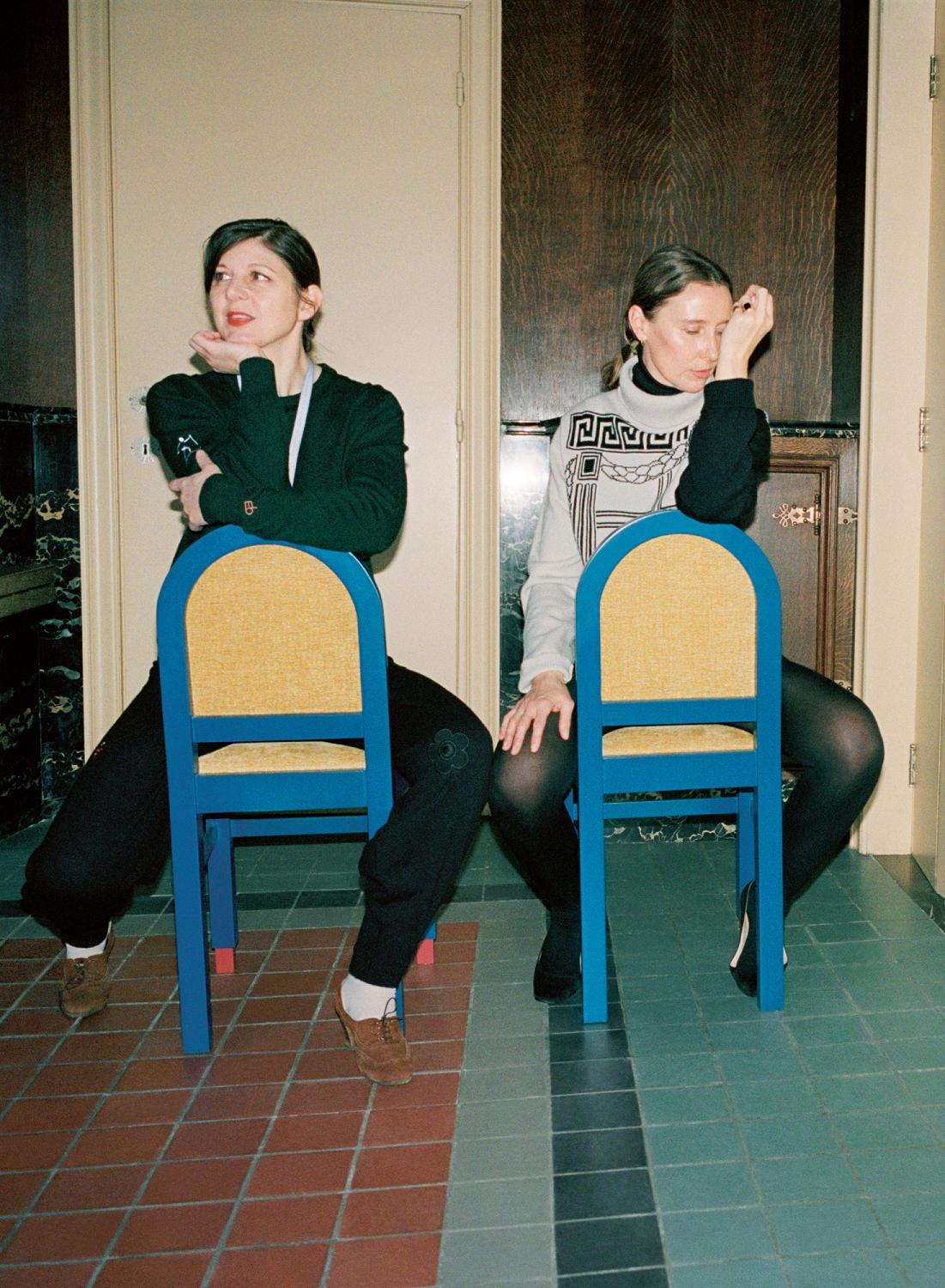
Above, Lucy wears an embroidered cashmere jumper and embroidered cashmere trousers, both from Atelier E.B’s Dash People collection, 2021, with white socks. The brogues are worn throughout. The DCI Lanyard necklace is from the Jasperwear collection, 2018. Beca wears a cashmere intarsia polo-neck jumper over a silk-and-cashmere top, both from the Ost End Girls collection, 2013. Throughout, Beca wears black shoes, black tights, gold earrings, rings and coffee-bean necklace.
Born in 1977, Lucy spent her teenage years making music and fanzines before discovering at the Duncan of Jordanstone College of Art & Design in Dundee that she loved to paint. She takes feminine, lowbrow and much-maligned subjects, such as cats, popular crime fiction and the silver Charles Rennie Mackintosh-inspired “Mockintosh” motifs that have proliferated in Scottish gift shops since Glasgow’s 1990 stint as the European Capital of Culture, and gives them a new life through her art, using near-obsolete crafts such as lacemaking and the trompe l’oeil and other fine techniques she acquired during her time at the Van der Kelen-Logelain school of decorative painting in Brussels in 2007–08. Wry, quiet subversion suffuses her work, whether she’s furnishing the suburban Sudbury Town London Underground station with hand-painted hoardings for irresistible (yet imaginary) cosmetics and unreliable maps of the environs or creating her “quodlibets” — assemblages of objects typically found on a desk that look real but are painted. One is subtitled “Janette Murray”, after the woman who coordinates hand-knitting for Atelier E.B; it depicts a cork pinboard, knitting needles with wool, patterns and a map annotated with the locations of real-life “chronic” knitters.
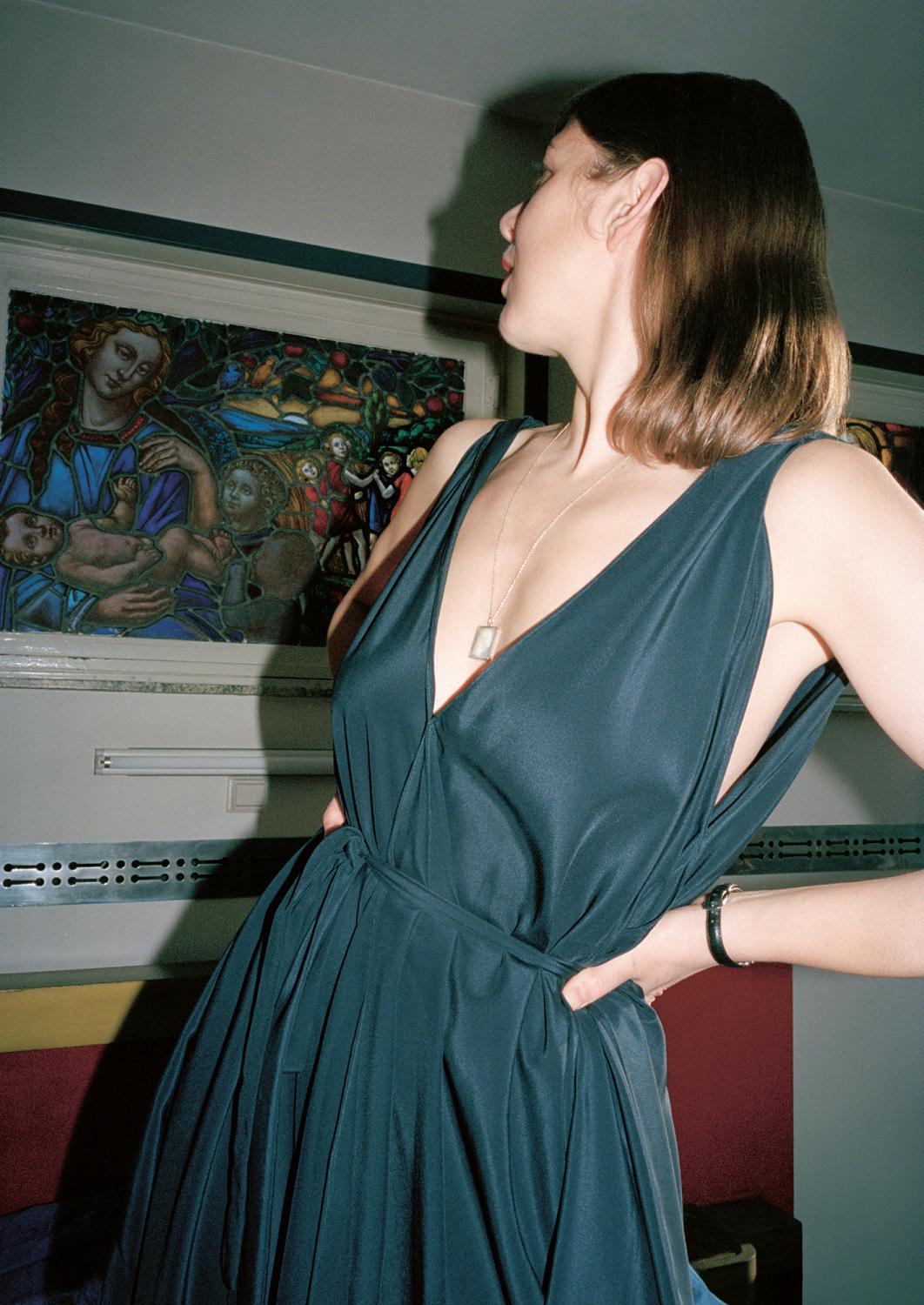
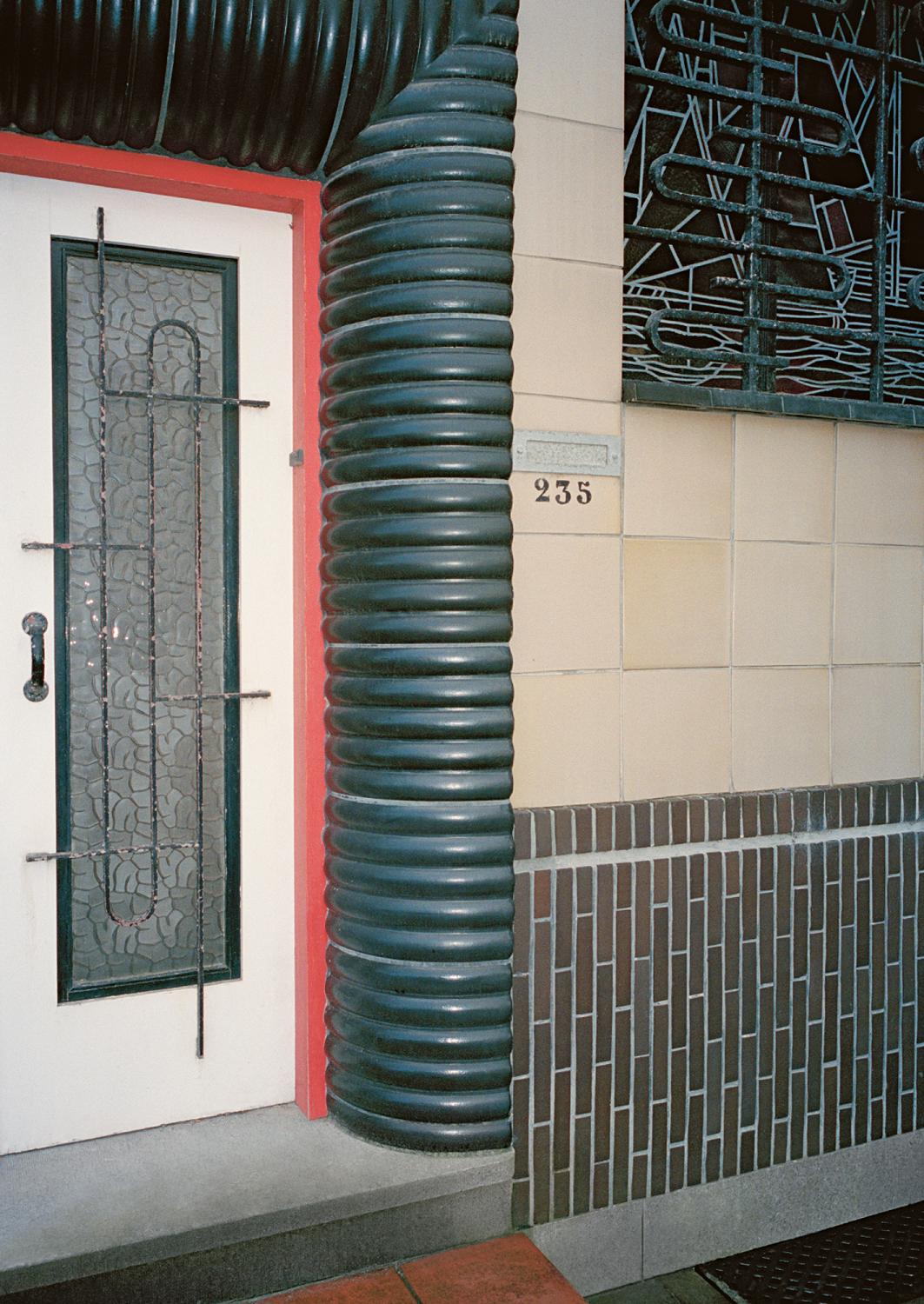
Lucy is wearing her own silk replica of Madeleine Vionnet’s 1920 Quatre Mouchoirs couture dress. The DCI Lanyard necklace is from the Jasperwear collection.
“In some ways it’s like having a muse, but we’re also each other’s sounding boards and assistants.”
Beca, 48, lives in a former whisky bond in Leith with her 19-year-old daughter, Bonnie, next door to her mother, the tapestry weaver Elizabeth Radcliffe. She graduated from Central Saint Martins in 1999 and set up a sporty eponymous label alongside her freelance work for various designers and style publications throughout Europe. She assisted Stella McCartney in her Autumn / Winter 2001 presentation (McCartney’s last as the creative director of Chloé), stencilling faces onto mohair jumpers for a collection that was praised for its mature edge — and whose velvet hipsters surely possessed something of the Beca Lipscombe DNA.
Beca first set eyes on Lucy in 2000, as the latter was chatting to her mother in the corner at an exhibition opening at Inverleith House, the 18th-century pile turned contemporary art space in the grounds of the Royal Botanic Garden Edinburgh. “What I didn’t know was that that was her work on the walls,” says Beca, who is today dressed in immaculate layers and Nike Pegasus ’83 trainers. She thought Lucy would make a great model for her clothes. “She’s got what I term Scottish skin, like in Gregory’s Girl,” Beca says, referencing the 1981 Scottish romantic comedy starring Dee Hepburn. “She looks like she’s never had a suntan — the opposite of me, who’s frazzled myself since childhood.” She managed to get Lucy’s number.
Soon after the Inverleith House encounter, Lucy became one of Beca’s go-to models as Beca freelanced her way around the fertile fashion landscape of the early 2000s. “I remember being sort of half woman, half zebra on the wall of Stella McCartney’s boutique in New York,” Lucy says, referring to her portrayal in the 500-square-foot mural Beca and her ex-partner, the graffiti artist turned illustrator Bernie Reid, and their friend Tonia created for McCartney’s store in the Meatpacking District.
Of meeting Beca, Lucy recalls, “I loved her clothes, loved spending time with her and was always pumping her for information about what she did, the world she came from and her education.”
Then, while preparing for a solo show that toured Britain in 2007, Lucy had an idea of how she might get to work with Beca in a more substantial way. “I approached her and I said, ‘I’d like to sublet part of my show to you, so that your clothes can come to all these university towns, rather than boutiques,’” Lucy tells me. A Guardian write-up of the exhibition, called Ten Years of Robotic Mayhem (Including Sublet), admired how “shopping, fashion, friendship and music jostle here with loftier concepts.”
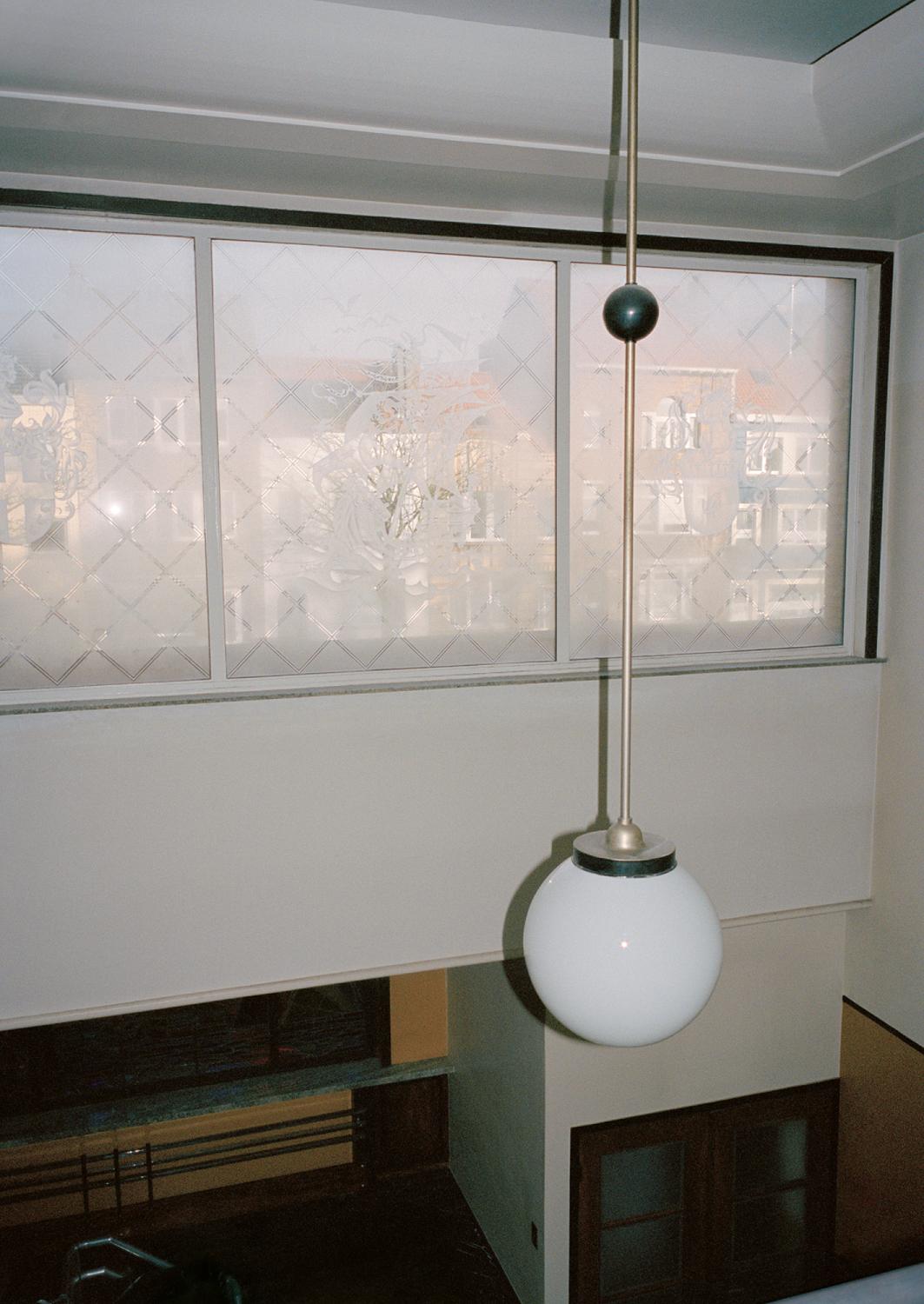
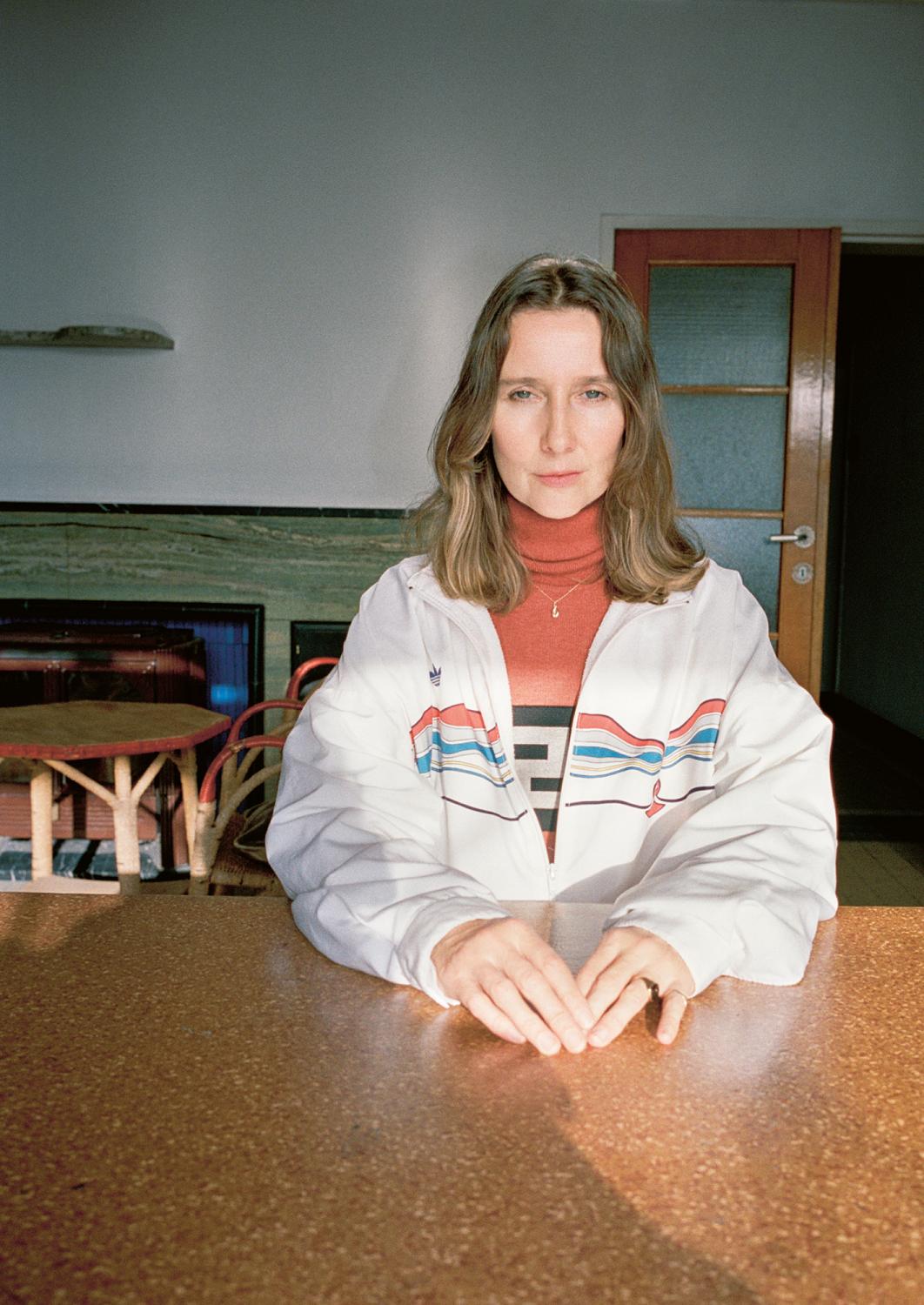
Beca is wearing a silk-and-cashmere polo-neck jumper with Meander-pattern bandeau from the Jasperwear collection. The Adidas tracksuit jacket is second-hand, from St Columba’s Hospice Care.
“We don’t have to delegate or even ask permission. But Lucy is an artist, she’s not a designer, and I’m not an artist.”
Tasks such as entreating a venerable art institution to loan them out a treasure for display in an Atelier E.B museum show are assigned intuitively, Lucy says. “When something works, you sort of don’t know why. It’s only when things start to break down that you come to contemplate the workings of it. In some ways it’s like having a muse, but we’re also each other’s sounding boards and assistants.” (Their relationship extends into Lucy’s art, too. Beca remembers that when Lucy wanted to depict a naked woman’s body in the immense Mooncup painting which graced Ostend’s Mu.ZEE, the “model” was ultimately composed of Lucy’s head and Beca’s body: a biological cut and shut.)
Sometimes Beca presents Lucy with choice items from the St Columba’s Hospice Care shop on Leith Walk, where she volunteers on a Monday (after tennis), sorting donations, “deciding what to keep, rag or throw out. It’s a never-ending archive of how clothes have been manufactured from the last century to now.” Lucy says, appreciatively, “She always brings me stuff that I wouldn’t expect. This one dress looked a bit like that ruched yellow dress Kate Moss wore, except it was pink. Beca suggested I wear it in summer with a 1930s sports shoe, and suddenly it wasn’t Kate Moss any more, it was Hoyningen-Huene.” Their pally exchange of styling references, taking in everything from a peak-exposure Kate Moss to a 1930s photographer of models poised in very early sportswear, speaks to teenage years spent reading magazines and sleeve notes pre-internet.

Beca is wearing an intarsia cashmere tank top over a cashmere polo-neck jumper with cashmere trousers, all from The Inventors of Tradition collection, 2011. Lucy’s in a polyester coat over a cashmere polo-neck jumper with a silver-and-plastic printed pendant necklace — all from the Jasperwear collection. The embroidered trousers are as before and are worn with black socks.
References abound in Atelier E.B’s latest collection, Dash People, which is named after Dash, a defunct high-street brand whose jewel-hued sweaters were daubed with figures in various states of athleisure. My mother and her friends were devotees of the original Dash in the late 1980s, and seeing the once-ubiquitous printed hieroglyphs re-created in Belgian lace on the fronts of baseball caps and cashmere separates is both transporting and disconcerting. Like the trompe l’oeil marbling in Lucy’s artistic practice, they constitute a reproduction that’s more painstaking — and more highly prized — than its source material.
To illustrate their working method, Lucy described the making of a sweatshirt that has ended up in the latest collection. “Beca will do the front of a sweatshirt, and I’ll be like, ‘I know exactly what should be on the back of that,’” says Lucy, who today is wearing a red North Face parka and Turnbull & Asser horizontal cords. “For example, it should look like a band world tour T-shirt, but instead of venues it should list all the shops that we want to sell in.” For the record, those fantasy stockists include the defunct UK department store chain What Everyone Wants and Sanborns, a restaurant in the Centro Historico district of Mexico City.
Thanks to its made-to-order model and the combined cross-disciplinary networking power of its founders, Atelier E.B is uniquely placed to draw the arty women (and men) who support it ever further into its ambit. Engagement can be as simple as a social media post showing the artist Martin Creed enjoying his Tonia cashmere tank top with hand intarsia geometric detail, the powerful American art patron and collector Thea Westreich Wagner in the brand’s Ivan Lendl tracksuit, or the Turner Prize winner Charlotte Prodger, who has championed the brand since she bought a long-sleeved organic Calton T-shirt (which she wore when she represented Scotland at the Venice Biennale in 2019).
In a less starry realm, Atelier E.B proudly sponsored the Leith Athletic ladies’ all-ages team in 2015. “They were bad,” Lucy says matter-of-factly, “but it felt good at the time to be a fashion label sponsoring a women’s football team.”
Places like Ostend (“it’s very working-class tourism here, not too chi-chi,” Lucy says) provide the kind of left-field — even frumpy — inspiration that’s thin on the ground in the world’s fashion capitals, while helping to keep things in perspective. That’s not to say Ostend doesn’t have its stardust. Beca has done the tour devoted to Marvin Gaye, who, she tells me, moved here in 1981 at the advice of his Belgian concert promoter. “You get headphones, and you go around where he used to drink, where he used to run on the beach,” she says. “It’s brilliant. I mean, it’s crap, but it’s brilliant.” For a while Ostend was a favourite Grace Jones haunt, Lucy adds.
In their conversation, allusions to music are as frequent as references to art and fashion. “I’ve actually made a comparison between the Pet Shop Boys and Lucy and me,” Beca says. “Lucy’s Neil Tennant and I’m Chris Lowe. Lucy holds forth like Neil does, but that doesn’t mean I’m not rabbiting on. If you ask the Pet Shop Boys where they start and stop, they don’t know either. It’s just a friendship that’s gone on.” (In September, the Pet Shop Boys drew attention to Atelier E.B’s Ost End Girls baseball caps via their Instagram feed.)
And so it is with Lucy and Beca. Back when she was at the helm of her own fashion brand, Beca recalls being “incredibly lonely”. “But with Atelier we get to share experiences good and bad.”
I ask her to describe an Atelier E.B low moment.
“In New York, we had to assemble a paravent together. They’re pretty heavy, and Lucy dropped her side of it into my fabric side, and it ripped in half.”
How did they make it work?
“We covered it in velvet.”
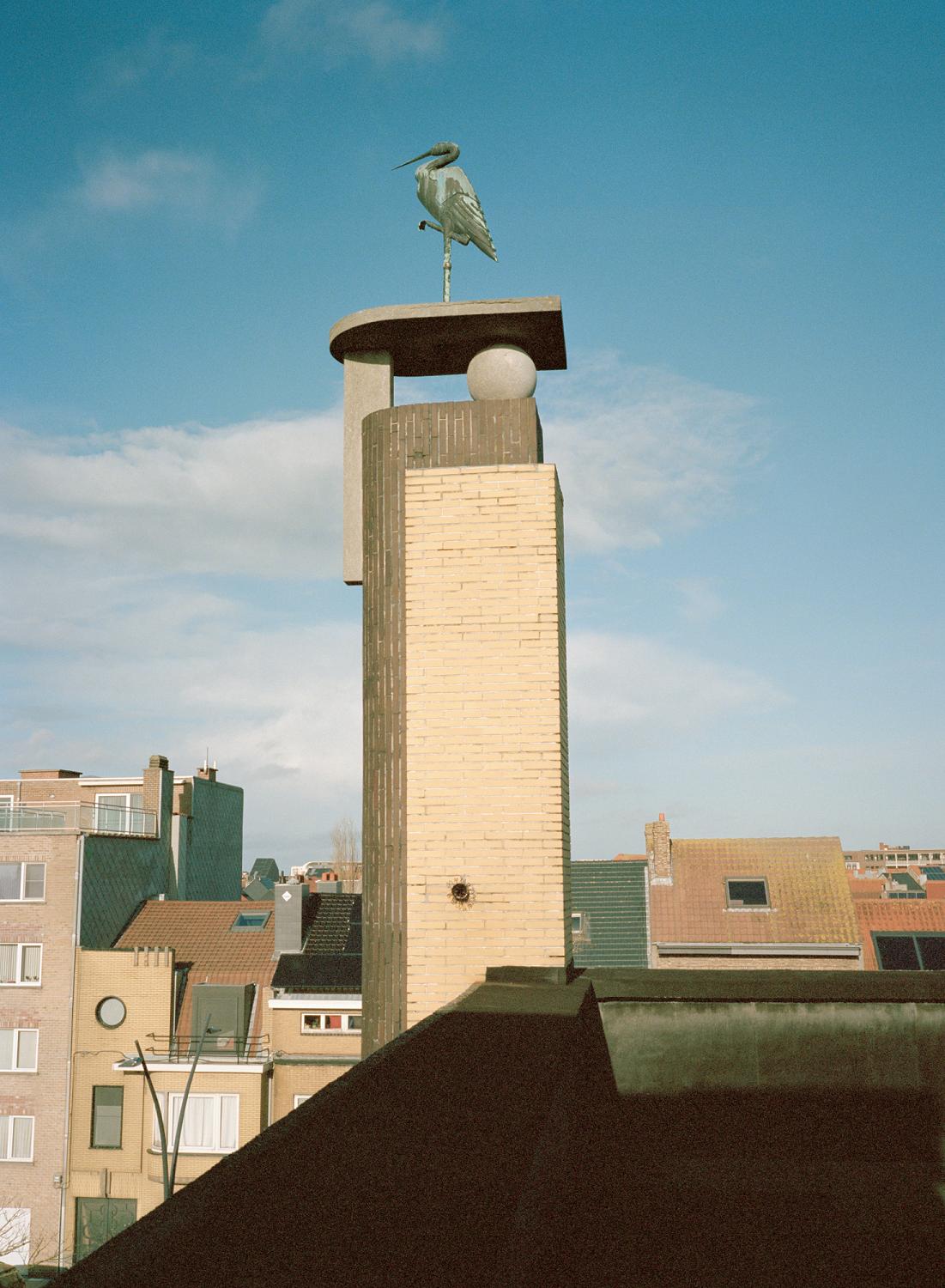
Mark SmithLondon-born, Amsterdam-based Mark has edited titles including Time Out Amsterdam and the Soho House members’ magazine. His investigative podcast series, Safe House, is rumoured to be coming soon. His first contribution to The Gentlewoman was in Issue nº 15, and he has been our digital editor since…read more Portraits by
Andrea Spotorno The Italian photographer Andrea Spotorno is a regular contributor to magazines such as Purple magazine, Fantastic Man, Numèro and Another Magazine. He has also shot for brands including Céline, Hermès and Valentino. With perhaps the firmest handshake in fashion, Andrea lives in Paris where he is…read more
Hair: Pablo Kuemin at Bryant Artists. Photographic assistance: Eleonora Gustapane. Styling assistance: Joëlle Laederach. Production: Bird Production.
This profile was originally published in The Gentlewoman nº 25, Spring & Summer 2022.